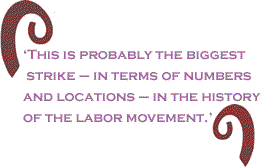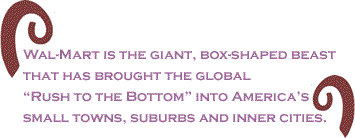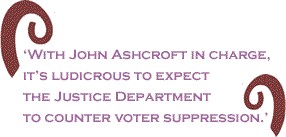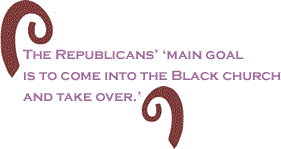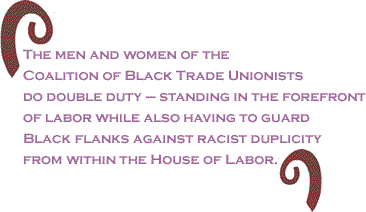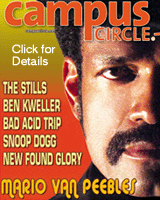
|
||||||||||||||||||||||
| sample
article page with #400 and #66 size ads
|
|
“You are demanding that this city will respect the dignity of labor. So often we overlook the work and the significance of those who are not in professional jobs, of those who are not in the so-called big jobs. But let me say to you tonight that whenever you are engaged in work that serves humanity and is for the building of humanity, it has dignity and it has worth.” – Dr. King, addressing striking sanitation workers in Memphis, April 3, 1968, the night before his assassination. hirty-six years after Dr. King’s death, Black labor confronts the living embodiment of what the civil rights leader called “the triple evils” – racism, economic exploitation, and militarism. His name is George Bush. “Most analyses say that this guy is beatable,” said Bill Lucy, President of the Coalition of Black Trade Unionists at a meeting of CBTU leadership in Orlando, last week. “The question is, can we put together a game plan to do that?” Back in September 1972 Lucy – then and now Secretary-Treasurer of AFSCME, the public employees union – joined with four other Black labor leaders to found the CBTU. They were outraged that AFL-CIO President George Meany had all but ensured the re-election of Richard Nixon by failing to back Democratic challenger George McGovern. Meany’s insistence on labor “neutrality” in the race – a position arrived at without consultation with African American unionists – would “almost certainly result in four more years of favored treatment for the rich and powerful; continued unemployment; frozen wages; high prices; appointment of additional members of the U.S. Supreme Court who are conservative and insensitive to the rights of workers, minorities, and the poor; more repression and restriction of civil liberties; and the reversal or total neglect of civil rights," the CBTU founders warned.
In hindsight, Richard Nixon’s White House looks like a liberal club compared to the piratical Bush regime. As Lucy’s CBTU executive council and chapter presidents gathered in Orlando to plan electoral strategy and celebrate the birthday of Dr. King, Bush stuck a “finger in the eye” of Blacks and Democrats by circumventing Congress to appoint racist Mississippi Judge Charles Pickering to the federal appellate bench. The day before, Bush wooed Black preachers in New Orleans with promises of faith-based funding and provoked angry demonstrations in Atlanta when he intruded on King’s gravesite to lay a wreath, then headed across town to picked up a $1.3 million check from rich Republicans. Bush seemed malevolently energized by King Week, whirling around the South like a confederate Tasmanian Devil, trashing King’s legacy at every stop. With just a 50 percent overall rating, Bush seems vulnerable in November. According to a CBS/New York Times poll, Bush remains the choice of 56 percent of white voters, but only 17 percent of African Americans approve of his performance – a figure that is almost certainly overstated. Nevertheless, AFL-CIO leadership is committed to a 16-state “battleground” strategy that complicates the CBTU’s task of mobilizing its nationwide Black constituency. This year, the flow of union money will be dictated by an electoral vote wish-list that does not match the geography of Black America: Arkansas, Florida, Iowa, Maine, Michigan, Minnesota, Missouri, Nevada, New Hampshire, New Mexico, Ohio, Oregon, Pennsylvania, Tennessee, Washington and Wisconsin. The Democratic Party hasn’t garnered a majority of white votes since Lyndon Johnson’s landslide victory over Barry Goldwater in 1964. Yet the very weakness of the Party among whites – coupled with data that indicate white union households and new Hispanic voters may hold the key to victory – makes the logic of “the map” irresistible to AFL-CIO strategists. It’s a done deal, one that appeared to have been accepted as a fait accompli by Bill Lucy and other CBTU leaders gathered at Orlando’s Royal Plaza Hotel on Dr. King’s weekend. The Wal-Martization of America Florida is a key battleground state, “the scene of the crime – the biggest voting rights crime in history,” as AFL-CIO President John Sweeney puts it. Orlando is a bright spot for Democrats on the politically roiling peninsula. Though the town is famous for the racist-founded Disney empire, Orlando’s pro-union Democratic mayor, Buddy Dyer gave Sweeney the Key to the City and welcomed a boisterous, labor-heavy Martin Luther King parade and voter drive, on Saturday.
But a dark specter hung over the marchers on Orlando’s streets and the CBTU meeting room back at the hotel. Seventy thousand southern California union grocery workers had passed the hundred-day mark of a strike and lockout, many having exhausted their health benefits as of January 1. "I've never seen anything like this in 19 years," said United Food and Commercial Workers (UFCW) spokesperson Ellen Andreder, in California. "This is probably the biggest strike – in terms of numbers and locations – in the history of the labor movement. The Teamsters and other unions see a direct link: no industry would be immune [from cuts in benefits] if they get away with it here.” Supermarket earnings rose 91 percent over the past five years, said Andreder, yet Safeway and Kroger are determined to gut union health benefits and establish a two-tier system of hiring. In San Francisco, the area Labor Council announced a boycott of Safeway in solidarity with UFCW strikers. “These grocery workers are not striking over $5 to $15 a week in health-insurance premiums, like the supermarkets claim,” said council Secretary-Treasurer Walter L. Johnson. “Current employees would have to pay $95 a week out of a $12 an hour salary for healthcare by the third year of the contract. Safeway is trying to basically eliminate healthcare for new hires – going back on its commitment to provide good union jobs in our communities – even though it continues to make huge profits.” Everybody knows where the anti-union pressures are coming from. “This strike is a Wal-Mart strike,” said Willie L. Baker, Jr., UFCW International Vice President and field operations chief, addressing fellow CBTU leaders in Orlando. “It’s really about how Americans finance health care. Will it be every man for himself?”
Wal-Mart is the twisted face of capitalism in George Bush’s America, the looming corporate presence whose name packs as much fear and loathing as did Birmingham police chief Eugene “Bull” Connor in Dr. King’s day. Wal-Mart, the world’s largest corporation, is implacably anti-union, pays less than $10 an hour, provides virtually no benefits, and plans to build 40 “super-centers” in California over the next five years, selling groceries alongside products from every low wage corner of the planet. Just as Bush personifies Dr. King’s “triple evils,” Wal-Mart is the giant, box-shaped beast that has brought the global “Rush to the Bottom” into America’s small towns, suburbs and inner cities. Wal-Mart dominates U.S. retailing on a scale that is “hard to absorb,” writes Charles Fishman in the December issue of the trade magazine, Fast Company:
Wal-Mart’s gargantuan size and merciless business methods compel competitors and vendor companies to become “shadow versions of Wal-Mart itself,” writes Fishman. Wal-Mart relentlessly lowers the bar for labor-management relations, wreaking havoc far beyond its own shelves. “The shipping strike was a Wal-Mart strike,” said UFCW vice president Baker, seated with his CBTU colleagues around a large, rectangular table in the Orlando hotel meeting room. Shipping companies provoked recent actions on West Coast docks largely because of intense pressure from Wal-Mart, which had repeatedly “complained that shipping rates were too high,” said Baker. This “different order of corporate being” poisons the social environment, obliterating civilized standards of business conduct towards competitors, vendors, consumers and – most devastatingly, workers. The infection spreads like a virus in a packed boardroom, both compelling and emboldening Safeway and Kroger to savage their own employees. “If Safeway has its way, children will go without medical care, families will be forced into poverty, and people will be moved from work to welfare for their health care protection,” warns the UFCW’s website. "The company is asking for such dramatic takeaways that if they win, workers will lose everywhere.” Poll watching is critical
Wal-Mart is George Bush’s kind of company, the behemoth at the import end of the domestic disinvestment loop that begins with the export of U.S. jobs to the low wage world. From points south and west across the Pacific the retail monster sucks up merchandise for sale to families that formerly made such goods. Ultimately, the abominable engine wipes the landscape clean of all competitors and impoverishes its own customers. While Wal-Mart and its corporate protégés lock their employees (literally) into abject impotence, the Bush regime seals the door shut through its war on the public safety net. The Bush/Wal-Mart vision of America is labor locked in a box. Add to this scenario historical racism and the ever-present threat of back stabbing by delusional white workers, and you will have arrived at the diabolical dilemma faced by the guiding members of the Coalition of Black Trade Unionists, in Orlando. Said Willie Baker, of the grocery workers union: “Everybody is looking at UFCW in California. It’s a helluva war for us…and this is a war.” (To donate to the war chest online, click here.) Longtime activist Cecelie E. Counts is Director of the AFL-CIO’s Department of Civil, Human and Women’s Rights – and a get-out-the-vote dynamo. The 16 strategic “battleground states” map has enough color in it to keep Counts busy through November. She noted that all the targeted states “have substantial minorities” with the exception of Maine and New Hampshire. Plus, Counts wants to expand the conventional base of African American activism. “I would hope that you would be recruiting, frankly, Black people with an accent. Reach out to the Black Latinos in our community.” Nobody in the room took seriously the Republicans’ announced goal to win 25 percent of the African American vote. The reincarnated Dixiecrats of the GOP specialize in keeping the largest possible number of Blacks away from the polls. “It’s going to be absolutely critical that we be poll watchers,” said Counts. “With John Ashcroft in charge, it’s ludicrous to expect the Justice Department to counter voter suppression.” Kenneth Diggs and Dorothy Townsend are also part of the AFL-CIO’s elections machinery. Voices for Working Families is one of three so-called 527 outfits that will receive tens of millions in “soft” funding this elections cycle. Diggs and Townsend believe that sophisticated polling techniques will help to spend the money smartly. “Our polls show that issues move our communities,” said Diggs in his presentation to the CBTU. Townsend assured the labor leaders that “We can tell on any given day what the issue is in the community. My students can challenge any pollster in the United States.”
Sophistication is in order, here. Republicans have attempted to push forward their own set of “Black” issues tailored to African American “social conservatives” who oppose abortion, gay marriage and other issues that motivate similarly self-identified whites. However, such issues have never caused significant numbers of Blacks to cross over to the Republicans. As University of Maryland political scientist Ron Walters told the Atlanta Journal-Constitution: “If you look at black people's lives, there are a lot of real problems," he said. "Gay marriage is not one of them. I can just see a black father coming home unemployed saying, 'I voted to stop gay marriage… Sorry you don't have any food.'" Jobs continue to be the overarching issue in Black America, and for good reason. A Republicons.org analysis shows “the number of unemployed African-Americans rose from 1.27 million in December 2000 to nearly 1.7 million in December 2003 – the rate jumped from 7.6% to 10.3% (a 2.7% increase).” The real Republican Black “outreach” program this election year is quite simple: Bush spends public money on faith-based programs to lure the morally-challenged segment of the Black clergy to the GOP camp, as he did in a highly publicized visit to New Orleans on King’s birthday. Miami’s Bishop Victor T. Curry, an indefatigable activist and radio station manager (WMBM-AM) drove half the night to Orlando to confer with Black labor. The Republicans’ “main goal is to come into the Black church and take over. Bush is trying to pick us off one by one,” said the Bishop. Faith-based bribery is taking its toll. The AFL-CIO’s Cecelie Counts agreed, with a passion: “We’ve got to step on these people like roaches. We have to educate our own communities, because nobody else is going to do this for us.” Otherwise, said Counts, sounding more like the anti-apartheid activist of her previous life, “We’ll have our own Mobutus.” Apartheid has its echoes in U.S. policy towards would-be Haitian immigrants. “The treatment of Haitians can only be understood through the lens of colonial history and racism,” said Dave Glaser, national coordinator of the Hotel Employees and Restaurant Employees International union (HERE), and a main mover in the recent, cross-country Immigrant Workers Freedom Ride. Glaser is also comfortable with labor’s strategic electoral map. “We will register immigrant workers where they are most under attack, that is, in Arizona and Florida.” Unfair labor practice A white-haired and somewhat weary AFL-CIO President John Sweeney spoke of the pain of knowing “deep in your heart that your employer is plotting right now to send your work and your livelihood overseas.” Hundreds of Black trade unionists at the MLK 75th Birthday Awards Dinner knew exactly what Sweeney meant. The 20 percent of African Americans who belong to union families, heavily concentrated in the disintegrating manufacturing sector, have paid a disproportionate price for the bipartisan Clinton-Bush jobs exportation program. African Americans, a people libeled for centuries as shiftless and lazy, are in reality “joiners” – the ethnic group most enthusiastic to join unions and to put in the long, unpaid hours necessary to keep their unions strong. The men and women of the Coalition of Black Trade Unionists do double duty – standing in the forefront of labor while also having to guard Black flanks against racist duplicity from within the House of Labor. Having paid a heavy surcharge to enter the House as equals, Blacks understood Sweeney when he said that “our research shows 45 million American workers would join our unions if they had a chance.” African Americans went through hell and high water for that chance. The mostly Black Royal Plaza Hotel crowd included many who remembered when guns won out over butter in the Sixties, as the War on Poverty became a domestic victim of the Vietnam War. They found nothing radical whatsoever in Sweeney’s statement that Bush and his crew have turned “warfare into a profit center, and Iraqi ‘reconstruction’ into a revenue stream.” Blacks are well acquainted with Dixiecrat morality and the infinite capacity of racists to debase national purposes. Slavery was a great “profit center” draped in religion, civilization and Manifest Destiny. White supremacy remains largely unreconstructed. Sweeney was preaching to a righteous choir. But it’s tough being the Black spine of a movement whose weakest links are white; to be constantly depended on to stand tall and do the right thing, while resources are unfailingly diverted to shore up weak white union households too deluded or stupid to respond correctly to the words of the old labor song, “Which side are you on?” CBTU President Bill Lucy spoke the unadorned truth when he told an Orlando community meeting: “If we let the debate assume that there are differences between black and white workers, we are all doomed. Working-class blacks and working-class whites have more in common with each other than they do with rich people.” African Americans have always understood the logic of unionism. False consciousness is a mass white problem. This election year, many tens of millions of dollars will be spent in the attempt to disabuse the white working class of its delusions. It’s not fair – call it an “unfair labor practice” – but Black unionists will adjust to the strategic “map” and its money grid, simply because they are men and women of superior intelligence who have their “eyes on the prize” and are informed by a unique history. More than any other sector of Americans – including other African Americans – Black labor understands the nature of the hybrid, corporate/racist beast, and that we are now engaged in a life and death struggle. As a young man rose to leave the CBTU executive meeting on Saturday, he remarked: “In 1987 Time Magazine asked the question, ‘Where have all the Black leaders gone?’” He paused, then turned to the big table that dominated the room. “Well, they’re here today.” |
January
22,
2004 |
|||||||||
|
|||||||||
|
|
|||||||||
| Printer Friendly Version | |||||||||
 |
|||||||||
| |
|||||||||
| |
|||||||||






















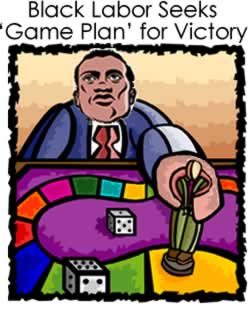
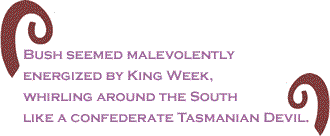
 “As
I have said many times, and believe with all my heart,
the coalition
that can have the greatest impact in the struggle for human
dignity here in America is that of the Negro and the forces
of labor, because their fortunes are so closely intertwined.”
“As
I have said many times, and believe with all my heart,
the coalition
that can have the greatest impact in the struggle for human
dignity here in America is that of the Negro and the forces
of labor, because their fortunes are so closely intertwined.” 